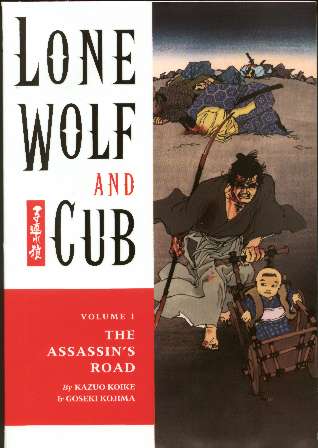

10-21-00
Lone Wolf and Cub - The Savage Sword of Itto Ogami
How many of you Western readers remember when "Savage Sword of Conan" was a GOOD comics magazine? When it had a real sense of larger-than-life adventure and heroic stature that made it stand well above its contemporaries? When Roy Thomas was THE writer and made the book his own, with the assistance of artists whose work could truly be called classic? It's been a long time since those days, but thankfully there is a comparable work available in the form of "Lone Wolf and Cub" by Kazuo Koike and Goseki Kojima.
Some previous fans of "Lone Wolf and Cub" may take offense at my comparing the book to Marvel's Conan work, probably on artistic grounds, with the claim that as a creator-owned book, it contains more artistic merit than Conan ever could. Unfortunately, it is this sort of pretentiousness that has mostly kept me away from Japanese work to date....the idea that because it is different, it must be better. Much manga and anime underwhelms me, despite my appreciation for Japanese culture....I just don't agree that most of the art is that good in most cases, and am not prepared to accept the idea that I just don't understand it. As a lifelong comics reader, with a grounding in not only the American style, but also much European work, I think I know by know how to read a comic book, and can tell quality work from hack or rehash. From what I have seen, the Japanese market as well as any other has its imitators and swipe artists, and a very much smaller number of true artists. Fortunately, the creators of "Lone Wolf and Cub" are of the latter group, and I have been able to put aside my preconceived notions to discover their work. My only regret is that I waited this long.
The story of Lone Wolf and Cub is not new....according to Maurice Horn in "The World Encyclopedia of Comics", the series began in the pages of "Manga Action" magazine in August 1970. It has been translated into "motion pictures, a television series, a number of records, and other things" (again from Horn). In 1987, First Comics began reprinting the series in deluxe format books, with great covers by Frank Miller. I don't think the project was ever finished. Now, Dark Horse Comics has taken up the reigns, and is publishing the entire run in a series of digest sized books (with those Frank Miller covers included), approximately 300 pages each, over the next year. The cover price (15 bucks in Canada!) is a bit steep, but in my opinion, it is one of the best buys for the money on the market this year.
As a longtime fan of the "Savage Sword of Conan" magazines (and to a lesser degree the color books), I have for years missed the tight, intense, no apologies, style of storytelling of Roy Thomas, and the moody, gritty artwork of the likes of John Buscema and the Crusty Bunkers. Sure, those people are still working, but they're just not doing the job as well as they used to. "Lone Wolf and Cub" brings the same sense of high adventure blazing right back, although in a decidedly different atmosphere.
The story concerns one Itto Ogami, the Lone Wolf, and his son Daigoro, the cub, natch. Ogami is a disgraced member of the Shogun's household who has chosen to follow the road of the assassin with his son. Many of the stories draw on the culture of the samurai in contrast to the environment of feudal Japan, demonstrating the difference between the discipline of bushido to the moral looseness of common life. The ultimate moral seems to be that even in the face of great adversity and loss, one can maintain a moral and spiritual centre and endure. The imagery and words with which this lesson is demonstrated are at times shocking, at times subtle, and always involving.
The individual stories are highly dramatic, with small to moderate amounts of dialogue, relying more on a precision of words than an abundance of them, as well as on environment and action, to develop the themes. The artwork seems to alternate between heavily hatched pen and ink and greywash (highly reminiscent of the work of the aforementioned Crusty Bunkers), each working just as well in the time and place of the stories.
Ultimately, "Lone Wolf and Cub" depends as much on the Eastern concept of the heroic male (if not the ideal one) as "Savage Sword" did on the Western concept...and the two visions prove to be not as separate as you might think. In each case, the core of the character is an unwavering code of self-discipline that sets itself outside of time and circumstance to create a person who resonates with a deep and wide sense of life. If, like me, you have missed this kind of depth and heroism in action-based literature, or if you are new to the medium and are seeking a quality product that does not conform to the mold of run of the mill superheroics, then I strongly suggest "Lone Wolf and Cub" as a good investment.